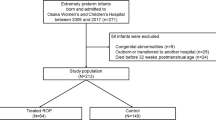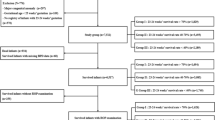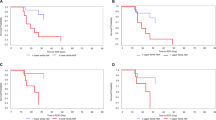Abstract
Background
Intermittent hypoxemia (IH) may influence retinopathy of prematurity (ROP) development in preterm infants, however, previous studies had mixed results. This study tests the hypothesis that increased IH is associated with Type 1 ROP; a stage beyond which treatment is indicated.
Methods
IH was quantified by continuously monitoring oxygen saturation (SpO2) using high-resolution pulse oximeters during the first 10 weeks of life. Statistical analyses assessed the relationship and predictive ability of weekly and cumulative IH for Type 1 ROP development.
Results
Most analyses showed no association between IH and Type 1 ROP adjusting for gestational age (GA) and birth weight (BW). However, cumulative IH of longer duration during weeks 5–10, 6–10, and 7–10 were significantly associated with Type 1 ROP adjusting for GA and BW, e.g., the adjusted odds ratio of Type 1 ROP was 2.01 (p = 0.03) for every 3.8 seconds increase in IH duration from week 6–10. IH did not provide statistically significant added predictive ability above GA and BW.
Conclusions
For most analyses there was no significant association between IH and Type 1 ROP adjusting for GA and BW. However, infants with longer IH duration during the second month of life had higher risk for Type 1 ROP.
Impact
-
The relationship and predictive ability of intermittent hypoxemia (IH) on retinopathy of prematurity (ROP) is controversial.
-
This study shows no significant association between IH events and Type 1 ROP after adjusting for gestational age (GA) and birth weight (BW), except for cumulative IH of longer duration in the second month of life.
-
In this cohort, IH does not provide a statistically significant improvement in ROP prediction over GA and BW.
-
This study is the first to assess the cumulative impact of IH measures on Type 1 ROP. Interventions for reducing IH duration during critical postnatal periods may improve ROP outcomes.
This is a preview of subscription content, access via your institution
Access options
Subscribe to this journal
Receive 14 print issues and online access
$259.00 per year
only $18.50 per issue
Buy this article
- Purchase on Springer Link
- Instant access to full article PDF
Prices may be subject to local taxes which are calculated during checkout


Similar content being viewed by others
Data availability
The data that support the findings of this study are available from the corresponding author upon reasonable request.
References
Kong, L., Fry, M., Al-Samarraie, M., Gilbert, C. & Steinkuller, P. G. An update on progress and the changing epidemiology of causes of childhood blindness worldwide. J. Am. Assoc. Pediatr. Ophthalmol. Strabismus 16, 501–507 (2012).
Kim, S. J. et al. Retinopathy of prematurity: A review of risk factors and their clinical significance. Surv. Ophthalmol. 63, 618–637 (2018).
Razak, A. & Faden, M. Association of small for gestational age with retinopathy of prematurity: A systematic review and meta-analysis. Arch. Dis. Child.-Fetal Neonatal Ed. 105, 270–278 (2020).
Seiberth, V. & Linderkamp, O. Risk factors in retinopathy of prematuritya multivariate statistical analysis. Ophthalmologica 214, 131–135 (2000).
Bharwani, S. & Dhanireddy, R. Systemic fungal infection is associated with the development of retinopathy of prematurity in very low birth weight infants: A meta-review. J. Perinatol. 28, 61–66 (2008).
Lad, E. M., Hernandez-Boussard, T., Morton, J. M. & Moshfeghi, D. M. Incidence of retinopathy of prematurity in the United States: 1997 through 2005. Am. J. Ophthalmol. 148, 451–458.e452 (2009).
Abu Jawdeh, E. G. Intermittent hypoxemia in preterm infants: etiology and clinical relevance. NeoReviews 18, e637–e646 (2017).
Di Fiore, J. M. et al. Prematurity and Postnatal Alterations in Intermittent Hypoxaemia. Arch. Dis. Child. Fetal Neonatal Ed. 106, 557–559 (2021).
Di Fiore, J. M. et al. A higher incidence of intermittent hypoxemic episodes is associated with severe retinopathy of prematurity. J. pediatrics 157, 69–73 (2010).
Di Fiore, J. M. et al. The relationship between patterns of intermittent hypoxia and retinopathy of prematurity in preterm infants. Pediatr. Res. 72, 606–612 (2012).
Poets, C. F. et al. Association between intermittent hypoxemia or bradycardia and late death or disability in extremely preterm infants. JAMA 314, 595–603 (2015).
Fairchild, K. et al. Clinical associations of immature breathing in preterm infants: Part 1—central apnea. Pediatr. Res. 80, 21–27 (2016).
Sullivan, B. A. et al. Early pulse oximetry data improves prediction of death and adverse outcomes in a two-center cohort of very low birth weight infants. Am. J. Perinatol. 35, 1331–1338 (2018).
Abu Jawdeh, E. G. Intermittent Hypoxemia in Preterm Infants Doctor of Philosophy (PhD) thesis, University of Kentucky, (2018).
Gomez-Pomar, E. et al. Relationship between perfusion index and patent ductus arteriosus in preterm infants. Pediatr. Res. 81, 775–779 (2017).
Ibonia, K. T. et al. Blood transfusions in preterm infants: changes on perfusion index and intermittent hypoxemia. Transfusion 58, 2538–2544 (2018).
Abu Jawdeh, E. G. et al. Prenatal opioid exposure and intermittent hypoxemia in preterm infants: A retrospective assessment. Front. Pediatr. 253, 1–7 (2017).
Jawdeh, E. G. A. et al. Intermittent Hypoxemia in Preterm Infants: A Potential Proinflammatory Process. Am. J. Perinatol. 38, 1313–1319 (2021).
Abu Jawdeh, E. G. et al. Extubation Readiness in Preterm Infants: Evaluating the Role of Monitoring Intermittent Hypoxemia. Children 8, 237 (2021).
Raffay, T. M. et al. Response to first dose of inhaled albuterol in mechanically ventilated preterm infants. J. Perinatol. 41, 1704–1710 (2021).
Rhein, L. et al. Transmitted home oximetry and duration of home oxygen in premature infants. Pediatrics 146 (2020).
Rhein, L. M. et al. Effects of caffeine on intermittent hypoxia in infants born prematurely: A randomized clinical trial. JAMA Pediatr. 168, 250–257 (2014).
Abu Jawdeh, E., Martin, R. J., Dick, T. E., Walsh, M. C. & Di Fiore, J. M. The effect of red blood cell transfusion on intermittent hypoxemia in elbw infants. J. Perinatol. 34, 921–925 (2014).
International Committee for the Classification of Retinopathy of Prematurity The international classification of retinopathy of prematurity revisited. Arch. Ophthalmol. (Chic., Ill: 1960) 123, 991–999 (2005).
Kamarudin, A. N., Cox, T. & Kolamunnage-Dona, R. Time-dependent Roc curve analysis in medical research: Current methods and applications. BMC Med. Res. Methodol. 17, 1–19 (2017).
Di Fiore, J. M. et al. Prematurity and postnatal alterations in intermittent hypoxaemia. Arch. Dis. Child.-Fetal Neonatal Ed. 106, 557–559 (2021).
Varga, T. V., Niss, K., Estampador, A. C., Collin, C. B. & Moseley, P. L. Association is not prediction: A landscape of confused reporting in diabetes - a systematic review. Diabetes Res Clin. Pr. 170, 108497 (2020).
Vagedes, J., Poets, C. F. & Dietz, K. Averaging time, desaturation level, duration and extent. Arch. Dis. Child.-Fetal Neonatal Ed. 98, F265–F266 (2013).
Claure, N. & Bancalari, E. New modes of respiratory support for the premature infant: automated control of inspired oxygen concentration. Clin. Perinatol. 48, 843–853 (2021).
Acknowledgements
We thank the research coordinators and research staff for assisting with subject enrollment and data collection. Special thank you to Sara Butler, RN, CCCE, and Crystal Wilson, LPN.
Funding
G.Y. was supported by National Institutes of Health (NIH) R01-EB028792, R01-HD101508,R21-HD091118, R21-NS114771, R41-NS122722, R56-NS117587, R01-AG062480. E.G.A wassupported by the National Center for Advancing Translational Sciences (UL1TR001998), NIHK23HD109471, and the University of Kentucky College of Medicine Dean’s Office. The contentis solely the responsibility of the authors and does not necessarily represent the official views of the NIH or University of Kentucky.
Author information
Authors and Affiliations
Contributions
E.G.A., G.Y., H.S.B and S.R.H. conceived the study. E.G.A. conducted and supervised human experiments. E.G.A. and P.B. acquired data. S.R.H. and L.C. analyzed and interpreted data. S.R.H and L.C. performed statistical analysis. E.G.A, P.B. and H.S.B provided resources for human experiments. S.R.H. drafted the manuscript. D.S., F.F., M.M., X.L., G.Y., L.C., E.G.A, H.S.B., Q.C., A.P., P.B. and S.R.H. reviewed and edited the manuscript. All authors gave final approval of the version to be published.
Corresponding authors
Ethics declarations
Competing interests
The authors declare no competing interest.
Consent statement
Under a protocol approved by the Institutional Review Board of the University of Kentucky, informed consent was obtained by the research team from each subject’s parent.
Additional information
Publisher’s note Springer Nature remains neutral with regard to jurisdictional claims in published maps and institutional affiliations.
Supplementary information
Rights and permissions
Springer Nature or its licensor (e.g. a society or other partner) holds exclusive rights to this article under a publishing agreement with the author(s) or other rightsholder(s); author self-archiving of the accepted manuscript version of this article is solely governed by the terms of such publishing agreement and applicable law.
About this article
Cite this article
Rabienia Haratbar, S., Chen, L., Cheng, Q. et al. The impact of intermittent hypoxemia on type 1 retinopathy of prematurity in preterm infants. Pediatr Res (2024). https://doi.org/10.1038/s41390-024-03169-5
Received:
Revised:
Accepted:
Published:
DOI: https://doi.org/10.1038/s41390-024-03169-5



